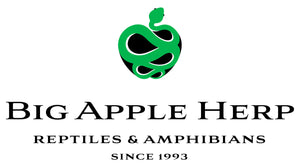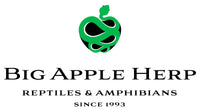The Leopard Gecko is one of the most popular choices for reptile lovers. Caring for this species of gecko is relatively simple plus they're generally docile and do not require a large cage. They are easy to breed and come in a vast amount of designer colors. At Big Apple Pet Supply, we carry only Captive Bred Leopard Geckos to maintain strict quality control.
Housing
One or two adult Leopard Geckos can be set up in an enclosure as small as a 20 gallon (30" x 12" x 13"H) but a larger enclosure of 30 to 40 gallons (36" x 18" x 13"H) would allow for additional room and a better design. We highly recommend a screen top to prevent crickets from escaping the enclosure.
You may house several similar size female Leopard Geckos together but even multiple females will compete for food so make sure any smaller geckos are receiving their share of the food, heat, etc. We do not recommend housing more than one male in an enclosure as males are territorial and typically will fight. One male and several females can generally be housed together but we recommend this for more seasoned reptile enthusiasts as there are multiple issues that can arise causing stress, shortened lifespan, etc. Regardless of sex, you should consider separating any vastly smaller or larger animals.
Substrate
For subadult and adult Leopard Geckos, sand such as Zoo Med Repti-Sand or Zoo Med Vita-Sand is usually the best choice substrate. Do not use industrial sand because it contains dust that that can be harmful. If you decide to use play sand use only extremely fine sand. Fine size play sand grain is hard to find which is why we recommend that you stick with reptile-specific products.
Baby Leopard Geckos are best kept on paper towels or similar product until they are about 5 inches long. As active feeders they usually ingest some of the substrate while gobbling up crickets or mealworms and while adults can usually digest some fine sand along with their food babies cannot handle this as well or at all. We have heard of baby Leopard Geckos becoming impacted with sand and not being able to pass it so please follow this advice.
Heating
As with all reptiles, Leopard Geckos need a thermal gradient consisting of a warm side (88° F) and a cool side (72° F). The best way to heat your Leopard Gecko’s enclosure is with a combination of heat mat and ceramic heat emitter. We recommend the Intellitemp Heat Mat and Big Apple Black Heat Infrared Ceramic Heat Emitter. The heat mat and ceramic heat emitter should be on one side while the other side should not have any heat source. We recommend controlling the ceramic emitter with a thermostat, such as the BAH-500 or BAH-1000DC, and monitoring the temperatures with a thermometer.
Lighting
Leopard Geckos are generally not active during the day and do not need a light or UV bulb. They often remain in a dark hiding place during the day so adding lights to a Leopard Gecko cage is not advisable since it can stress them out and actually cause health issues.
Shelter
Leopard geckos MUST have hiding places in their enclosure as it is essential to their well-being. The shelter can be anything from a Big Apple Basic Reptile Hide Box to a decorative reptile shelter, hiding hut or cave. It is always a good idea to have one shelter on the warm side and one on the cool side. If you choose to make a hiding place yourself, please make sure it is sturdy enough that there is no potential for collapsing and crushing your gecko.
Shedding
Like all reptiles and amphibians, Leopard Geckos shed their entire skin all at once. Babies shed more often than adults because as babies they outgrow their skin faster. It is not unusual to see Leopard Geckos eat their entire skin during the process of shedding since it contains valuable nutritional components. Geckos can normally pull their shed off easily but sometimes they have issues if they do not have the proper humidity while shedding. You need to check your gecko after it has shed to make sure it was able to peel all the skin off, especially from their toes. If shed skin is not removed promptly from the toe, the toe can become cut off from its blood supply and in time the toe can die and actually fall off. Your gecko is equipped with all its toes for a reason and while it is not usually critical to the gecko’s health to have all their toes, it is and easily preventable issue.
Providing a moist shelter will enable your gecko to have a high humidity location when it is shedding. Use moistened Big Apple Imported Premium Grade Sphagnum Moss or Zoo Med Forest Floor Bedding inside your gecko’s hide. If your gecko has retained skin after shedding you can place the gecko in a small plastic container lined with warm, wet paper towels. With the top of the container on, let the gecko sit for approximately 30 minutes. The high humidity in the container should loosen the skin enough to allow you to remove it easily with a pair of tweezers. If the skin has not loosened enough reheat the paper towels with warm water and provide another 30 minute session. NEVER use hot water as this can burn your gecko’s sensitive skin.
Water
It is true that Leopard Geckos typical environment is dry but they do require humidity and water. Water should be made available three to four times a week. Place the water dish on the cool side of the cage so that it does not evaporate quickly and make sure that your bowl is deep and big enough that your gecko can get into it but not so deep that it can potentially drown.
It is a good idea for baby Leopard Geckos to be misted occasionally and for the entire cage to be misted several times a week. This is especially true if your gecko is getting ready to shed its skin.
Food
Leopard Geckos are hardy eaters and will typically eat crickets, mealworms, giant mealworms, superworms, wax worms and small pinkie mice. However, wax worms and pinkie mice should only be offered occasionally due to their high fat content.
We recommend that you feed only as many crickets or mealworms as your gecko can eat in 10 to 15 minutes. It is important to select the proper prey size and the general rule for selecting the proper size of crickets is the cricket should be no longer than the length of the gecko's head. For baby geckos this usually means 3/8" crickets and for juvenile geckos 1/2" crickets and adult geckos can handle 3/4" crickets.
Vitamins
It is important to feed high quality food to your prey items, called "gut loading". The food that is in the prey item's belly is the food that your reptile will be eating. Zoo Med All-Natural Cricket Care offers complete gut load for you your crickets. In addition, you should coat your crickets and mealworms with vitamin and calcium powders, such as Zoo Med Repti Calcium with D3 or Rep-Cal Calcium, before feeding them to your reptile.
Cage Maintenance
Leopard Geckos require minimal maintenance as they usually go to the bathroom in one section of their cage. Sand substrates allow for quick cleaning of feces and using one of our scoopers you can perform this 2 to 3 times a week. The sand substrate should be completely thrown out and the entire cage, including all accessories, should be washed with Quat TB Pet Area Cleaner, Deodorizer & Stain Remover or a mild detergent at least once every four to five months. If using paper towels, change all paper towels at least once a week.
Hibernation
Hibernation while being natural for Leopard Geckos in the wild is not necessary for pet geckos. We believe you should heat your geckos throughout the winter so that they continue to eat, drink and be active. A general reduction in feeding behavior is normal during winter months due to temperature fluctuations in your house. As long as they keep fairly consistent weight it is generally not an issue and normal feeding typically resumes in the spring.


